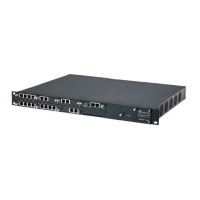User's Manual 464 Document #: LTRT-10632
Mediant 800B Gateway & E-SBC
Parameter Description
(i.e., alternative routing). You can configure a routing rule whose
matching characteristics is explicitly for calls with broken RTP
connections. This is done using the Call Trigger parameter, as
described in Configuring SBC IP-to-IP Routing Rules on page
709.
Note:
The device can only detect a broken RTP connection if silence
compression is disabled for the RTP session.
If during a call the source IP address (from where the RTP packets
are received by the device) is changed without notifying the device,
the device rejects these RTP packets. To overcome this, configure
the DisconnectOnBrokenConnection parameter to 0. By this
configuration, the device doesn't detect RTP packets arriving from
the original source IP address and switches (after 300 msec) to the
RTP packets arriving from the new source IP address.
The corresponding global parameter is
DisconnectOnBrokenConnection.
Media IP Version Preference
media-ip-version-preference
[IpProfile_MediaIPVersionPr
eference]
Defines the preferred RTP media IP addressing version for outgoing
SIP calls (according to RFC 4091 and RFC 4092). The RFCs concern
Alternative Network Address Types (ANAT) semantics in the SDP to
offer groups of network addresses (IPv4 and IPv6) and the IP address
version preference to establish the media stream. The IP address is
indicated in the "c=" field (Connection) of the SDP.
[0] Only IPv4 = (Default) SDP offer includes only IPv4 media IP
addresses.
[1] Only IPv6 = SDP offer includes only IPv6 media IP addresses.
[2] Prefer IPv4 = SDP offer includes IPv4 and IPv6 media IP
addresses, but the first (preferred) media is IPv4.
[3] Prefer IPv6 = SDP offer includes IPv4 and IPv6 media IP
addresses, but the first (preferred) media is IPv6.
To indicate ANAT support, the device uses the SIP Allow header or to
enforce ANAT it uses the Require header:
Require: sdp-anat
In the outgoing SDP, each 'm=' field is associated with an ANAT
group. This is done using the 'a=mid:' and 'a=group:ANAT' fields.
Each 'm=' field appears under a unique 'a=mid:' number, for example:
a=mid:1
m=audio 63288 RTP/AVP 0 8 18 101
c=IN IP6 3000::290:8fff:fe40:3e21
The 'a=group:ANAT' field shows the 'm=' fields belonging to it, using
the number of the 'a=mid:' field. In addition, the ANAT group with the
preferred 'm=' fields appears first. For example, the preferred group
includes 'm=' fields under 'a=mid:1' and 'a=mid3':
a=group:ANAT 1 3
a=group:ANAT 2 4
If you configure the parameter to a "prefer" option, the outgoing SDP
offer contains two medias which are the same except for the "c=" field.
The first media is the preferred address type (and this type is also on
the session level "c=" field), while the second media has its "c=" field
with the other address type. Both medias are grouped by ANAT. For
example, if the incoming SDP contains two medias, one secured and
the other non-secured, the device sends the outgoing SDP with four
medias:

